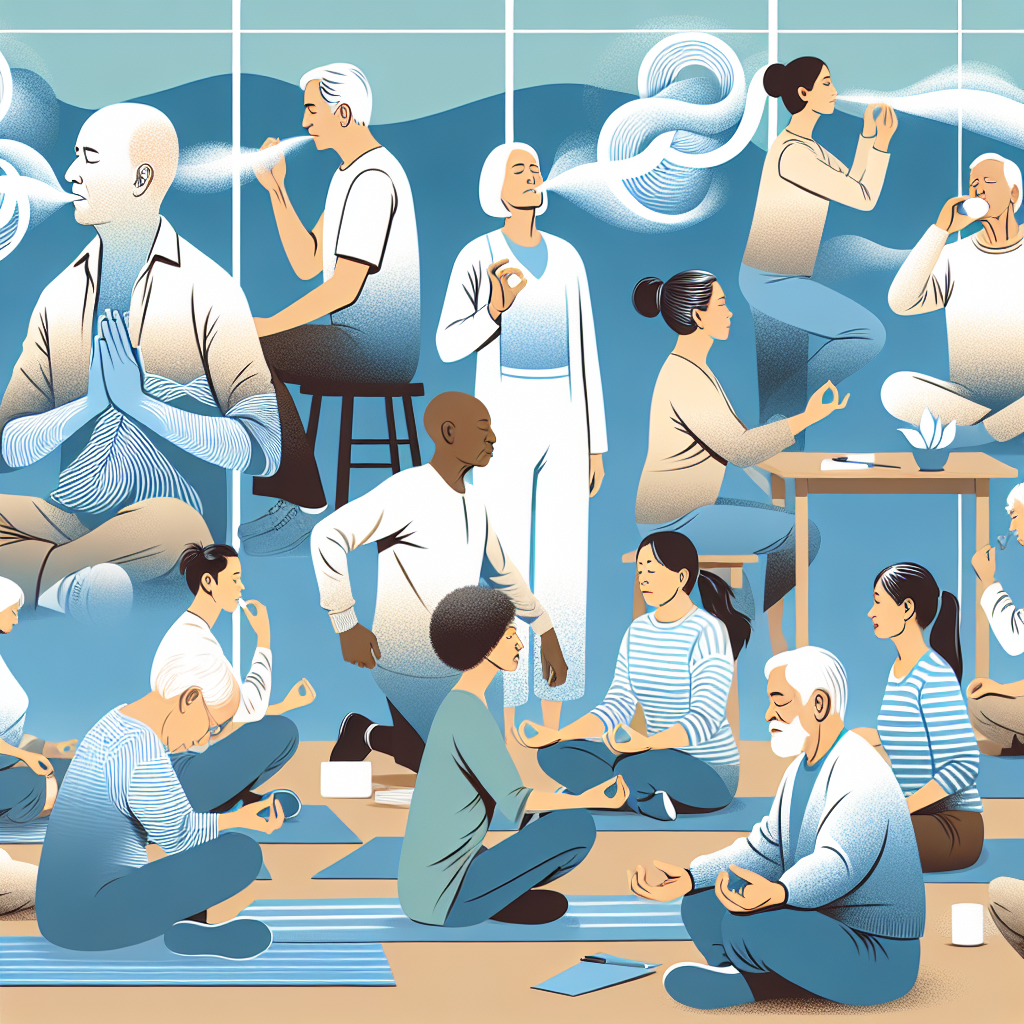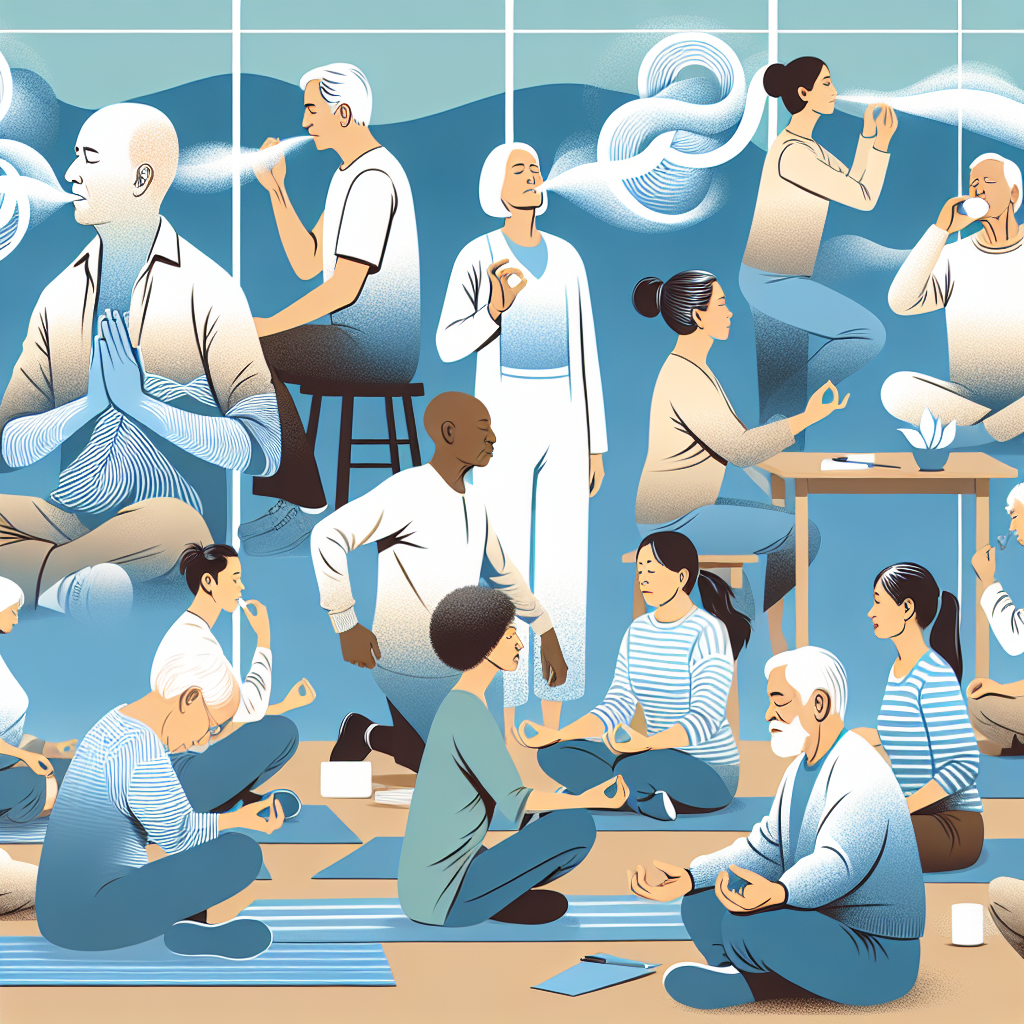Are you a senior looking for a simple and effective way to combat stress? Look no further than deep breathing exercises. In this article, we will explore how seniors can harness the power of deep breathing to find relaxation and relief from the daily stressors that can weigh them down. Whether you’re dealing with work-related anxieties, family pressures, or just the general demands of everyday life, incorporating deep breathing exercises into your routine can create a sense of calm and help you regain control. So, take a deep breath and let’s dive into the world of stress relief through deep breathing.

Benefits of Deep Breathing Exercises for Seniors
Reduces stress and anxiety
Deep breathing exercises are a simple and effective way for seniors to reduce stress and anxiety. When practiced regularly, deep breathing can activate the body’s relaxation response, calm the nervous system, and decrease the production of stress hormones. By taking slow, deep breaths, seniors can create a sense of calm and relaxation, allowing them to better cope with daily stressors.
Improves mental clarity and focus
Deep breathing exercises can also improve mental clarity and focus in seniors. By focusing on their breath and taking slow, deliberate breaths, seniors can quiet their minds and enhance their concentration. This can be especially beneficial for seniors who may experience cognitive decline or have difficulty staying focused.
Enhances respiratory function
Deep breathing exercises can help seniors improve their respiratory function and lung capacity. By taking deep breaths, seniors can expand their lungs and increase the amount of oxygen that reaches their bloodstream. This can improve overall lung health and increase energy levels.
Promotes relaxation and better sleep
Deep breathing exercises are known for their relaxation benefits, making them an excellent tool for seniors to promote better sleep. By practicing deep breathing before bed, seniors can relax their bodies and minds, making it easier to fall asleep and experience more restful sleep throughout the night.
Boosts immune system
Regular deep breathing exercises can also boost the immune system in seniors. Deep breathing increases the oxygenation of cells, supports the removal of toxins from the body, and activates the lymphatic system, which helps to fight off infections and illnesses. A stronger immune system can contribute to better overall health and well-being for seniors.
Regulates blood pressure
Deep breathing exercises have been shown to have a positive impact on blood pressure regulation. By engaging in deep, slow breaths, seniors can activate the body’s relaxation response, leading to a decrease in blood pressure. This can be especially beneficial for seniors who may be at risk for high blood pressure or cardiovascular issues.
Improves digestion and reduces bloating
Deep breathing exercises can aid in digestion and reduce bloating in seniors. By activating the parasympathetic nervous system, deep breathing promotes relaxation and supports optimal digestion. This can help alleviate symptoms such as bloating, gas, and indigestion, allowing seniors to maintain better digestive health.
Relieves muscle tension and pain
Deep breathing exercises are useful for relieving muscle tension and pain in seniors. By taking slow, deep breaths, seniors can promote relaxation in their muscles and increase blood flow to tense or sore areas. This can help alleviate discomfort and improve overall physical comfort.
Promotes overall well-being and happiness
Deep breathing exercises can contribute to overall well-being and happiness in seniors. By engaging in regular deep breathing practice, seniors can experience a greater sense of calm, relaxation, and contentment. Deep breathing exercises can be a simple yet powerful tool to improve one’s emotional state and promote a positive mindset.
Different Types of Deep Breathing Techniques
Diaphragmatic breathing
Diaphragmatic breathing, sometimes referred to as belly breathing, involves breathing deeply into the diaphragm, rather than shallowly into the chest. This technique encourages full lung expansion and can be done in a seated or lying position. Seniors can place their hands on their abdomen and focus on inhaling deeply, allowing the belly to rise, and exhaling fully, allowing the belly to fall.
4-7-8 breathing
4-7-8 breathing is a technique that involves inhaling for a count of four, holding the breath for a count of seven, and exhaling for a count of eight. This pattern is repeated several times and can help induce a state of relaxation in seniors.
Pursed lips breathing
Pursed lips breathing involves inhaling slowly through the nose and exhaling gently through pursed lips, as if blowing out a candle. This technique can help regulate breathing and encourage a slower exhalation, which can be beneficial for seniors with respiratory issues.
Box breathing
Box breathing is a technique that involves inhaling, holding the breath, exhaling, and holding the breath again, with each phase lasting for a specific count. The pattern forms a square, resembling the shape of a box. This technique can be a helpful tool for seniors to regulate their breath and promote a sense of calm.
Alternate nostril breathing
Alternate nostril breathing is a technique that involves closing one nostril with a finger while inhaling through the other nostril, then switching and exhaling through the closed nostril. This technique can help balance energy in the body and promote a sense of harmony and relaxation.
Progressive muscle relaxation with deep breathing
Progressive muscle relaxation combines deep breathing with the systematic tensing and releasing of different muscle groups. Seniors can start by tensing specific muscle groups, such as the shoulders or hands, and then release the tension while taking slow, deep breaths. This technique can help seniors further relax their bodies and relieve muscle tension.
Sama Vritti (Equal Breathing)
Sama Vritti, also known as equal breathing, involves inhaling and exhaling for an equal count, such as inhaling for a count of four and exhaling for a count of four. This technique allows seniors to focus on achieving a balanced breath and can promote a sense of tranquility.
Belly breathing
Belly breathing, as mentioned earlier, involves breathing deeply into the diaphragm, allowing the belly to rise and fall with each breath. This technique is particularly useful for seniors as it encourages a deep, relaxed breath, promoting both physical and mental relaxation.

Step-by-Step Guide to Deep Breathing for Seniors
Find a comfortable and quiet space
To practice deep breathing exercises, find a comfortable and quiet space where you can relax without distractions. This could be a quiet room in your home or a peaceful outdoor area.
Sit or lie down in a relaxed position
Once you have found your space, sit or lie down in a comfortable and relaxed position. You can choose to sit on a cushion or chair with your back supported, or lie down on a yoga mat or bed.
Close your eyes and tune in to your breath
Close your eyes to eliminate visual distractions and begin to tune in to your breath. Take a few moments to simply observe your natural breath without trying to change it.
Start with diaphragmatic breathing
Begin your deep breathing practice with diaphragmatic breathing. Place one hand on your abdomen, just below your ribcage, and one hand on your chest. Take a slow, deep breath in through your nose, allowing your belly to rise as your diaphragm expands. Exhale slowly through your mouth, allowing your belly to fall.
Practice proper breathing technique
When practicing deep breathing, it’s essential to use proper breathing technique. Inhale slowly and deeply through your nose, allowing your breath to expand your belly, ribcage, and chest. Exhale gently through your mouth, allowing your breath to naturally release.
Focus on the sensation of your breath
As you continue to practice deep breathing, focus on the sensation of your breath. Pay attention to the feeling of the air entering and leaving your body, the rise and fall of your abdomen, and the soothing rhythm of your breath.
Repeat for a set duration
Set aside a specific amount of time each day to practice deep breathing. Start with just a few minutes and gradually increase the duration as you become more comfortable. Aim for at least 10 minutes of deep breathing practice each day.
Gradually increase the duration of your practice
As you become more experienced with deep breathing, gradually increase the duration of your practice. This will allow you to deepen your relaxation response and experience the full benefits of deep breathing exercises.
Tips for Seniors to Maximize the Benefits of Deep Breathing
Find a consistent daily routine
To maximize the benefits of deep breathing, establish a consistent daily routine. Set aside a specific time each day that works best for you and make deep breathing a regular part of your schedule.
Create a peaceful environment
Create a peaceful environment for your deep breathing practice. Choose a quiet space where you can relax without interruptions or distractions. You may also consider creating a calming ambiance by dimming the lights, playing soft music, or using essential oils.
Combine deep breathing with meditation or mindfulness
Deep breathing can be even more effective when combined with meditation or mindfulness practices. Consider incorporating a few minutes of meditation or mindfulness into your deep breathing routine to further enhance relaxation and focus.
Experiment with different techniques
Don’t be afraid to experiment with different deep breathing techniques to find what works best for you. Try out different techniques like 4-7-8 breathing, alternate nostril breathing, or box breathing to discover which one resonates with you the most.
Incorporate deep breathing into your daily activities
Deep breathing doesn’t have to be limited to a dedicated practice session. Incorporate deep breathing into your daily activities by taking a few deep breaths during moments of stress, overwhelm, or even during routine tasks like washing dishes or walking.
Take deep breaths when feeling stressed or overwhelmed
When you’re feeling stressed or overwhelmed, take a moment to take a few deep breaths. Pause, close your eyes if possible, and focus on your breath. This can help bring you back to the present moment, calm your mind, and reduce stress.
Consider joining a deep breathing class or group
If you prefer practicing deep breathing in a group setting, consider joining a deep breathing class or group. This can provide you with a supportive community and the opportunity to learn from experienced teachers or practitioners.
Seek guidance from a healthcare professional
If you have any concerns or questions about incorporating deep breathing into your routine, seek guidance from a healthcare professional. They can provide personalized advice and ensure that deep breathing is safe and suitable for you.
Practice deep breathing as a preventive measure
Deep breathing isn’t just beneficial for stress relief – it can also be used as a preventive measure for overall well-being. By practicing deep breathing regularly, even when you’re not feeling stressed, you can maintain a sense of calm, mental clarity, and physical relaxation.
Maintain a positive mindset
Finally, maintaining a positive mindset can amplify the benefits of deep breathing. Approach your deep breathing practice with an open mind, curiosity, and a positive attitude. Embrace any challenges or setbacks as opportunities for growth and improvement.
Common Challenges and Tips to Overcome Them
Lack of consistency
One common challenge when it comes to deep breathing is lack of consistency. It can be easy to forget or skip a practice session. To overcome this, try setting reminders on your phone or incorporating deep breathing into an existing routine, such as doing it before or after brushing your teeth.
Difficulty finding a quiet space
Finding a quiet space can also be a challenge, especially if you live in a busy household or in a noisy environment. Consider using noise-cancelling headphones or playing soothing music or nature sounds to help create a more peaceful environment.
Distracted thoughts and external noises
It’s normal for the mind to wander or for external noises to distract you during deep breathing. When this happens, acknowledge the distraction and gently bring your focus back to your breath. Each time your mind wanders, simply return your attention to your breath without judgment.
Physical discomfort or pain
Some seniors may experience physical discomfort or pain while practicing deep breathing, especially if they have existing health conditions. If this happens, modify the technique or position to alleviate any discomfort. You can also consult with a healthcare professional for guidance.
Uncertainty about proper breathing technique
If you’re unsure about the proper breathing technique, seek guidance from a healthcare professional or a qualified instructor. They can demonstrate and provide instructions on how to perform deep breathing correctly and safely.
Resistance to trying new techniques
It’s common to feel resistance or hesitation when trying new deep breathing techniques. Remember that it’s okay to start slow and gradually incorporate new techniques into your practice. Be patient with yourself and give yourself time to adapt.
Impatience for immediate results
Deep breathing is a practice that requires patience and consistency to see long-term results. Try not to expect immediate results and focus on the present moment. Embrace each breath as an opportunity to relax and reconnect with yourself.
Feeling discouraged by initial difficulties
If you encounter difficulties or challenges in your deep breathing practice, such as feeling restless or having difficulty maintaining focus, remind yourself that it’s normal and part of the learning process. Be gentle with yourself and keep practicing.
Difficulty remembering to practice
To overcome difficulty remembering to practice, incorporate reminders into your daily routine. Set alarms or use sticky notes as visual cues to remind yourself to take a few moments for deep breathing.
Lack of motivation and dedication
Maintaining motivation and dedication can be challenging, especially when life gets busy. Remind yourself of the benefits you’ve experienced and commit to your well-being. Find inspiration by reading success stories or connecting with others who practice deep breathing.
Precautions and Considerations for Seniors
Consult with a healthcare professional before starting
Before starting any new exercise or wellness practice, it’s crucial to consult with a healthcare professional, especially if you have pre-existing health conditions or concerns. They can assess your individual needs and provide guidance specific to your situation.
Modify techniques based on physical limitations
If you have physical limitations or injuries, make sure to modify deep breathing techniques to accommodate your needs. For example, you might need to practice deep breathing in a seated position instead of lying down, or use props for support.
Avoid forceful or strenuous breathing
When practicing deep breathing, it’s important to avoid forceful or strenuous breathing. Always prioritize comfort and ease. If a technique feels uncomfortable or causes strain, adjust or switch to a different technique.
Take breaks if feeling lightheaded or dizzy
If you feel lightheaded or dizzy during deep breathing, stop and take a break. Sit or lie down, and allow yourself to rest until you feel stable again. If symptoms persist, consult with a healthcare professional.
Listen to your body and respect its limits
Pay attention to your body’s cues and listen to any discomfort or pain. Deep breathing should feel relaxing and invigorating, not uncomfortable or distressing. Modify or discontinue any technique that doesn’t feel right for you.
Adapt breathing exercises to a comfortable pace
Seniors may need to adapt breathing exercises to a comfortable pace that suits their individual needs. If a technique feels too fast or too slow, adjust the rhythm and tempo to find a pace that feels comfortable and natural.
Be patient and don’t push yourself too hard
Remember to be patient with yourself and avoid pushing yourself too hard. Deep breathing is a practice that takes time to master, so embrace each step of the journey and celebrate your progress.
Stay hydrated before and after deep breathing
Deep breathing can be a dehydrating practice, so it’s important to stay hydrated before and after your sessions. Drink plenty of water to ensure that your body stays well-hydrated.
If necessary, use props or support for comfort
If you require additional support or comfort during your deep breathing practice, consider using props such as cushions, blankets, or chairs. These can help you find a comfortable position and make your practice more enjoyable.
Don’t substitute deep breathing for medical treatment
While deep breathing exercises offer numerous benefits, they should not be substituted for medical treatment. If you have any health concerns or require medical attention, seek professional help and follow the advice of healthcare professionals.
Conclusion
Deep breathing exercises offer numerous benefits for seniors, from reducing stress and anxiety to improving respiratory function and promoting overall well-being. By incorporating deep breathing into their daily routines, seniors can experience a greater sense of calm, mental clarity, and relaxation. Overcoming common challenges and staying consistent with practice is key to fully reaping the benefits of deep breathing. It’s important for seniors to prioritize their safety and physical well-being, consulting with healthcare professionals and modifying techniques as needed. With regular practice, deep breathing can become a powerful tool for seniors to experience stress relief, improved mental and physical health, and enhanced overall well-being.
